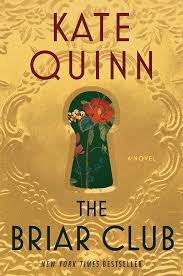The Briar Club, by Kate Quinn
Set in 1950s Washington, DC, The Briar Club takes place at a women’s boarding room house situated on the corner of Briar and Wood Streets, in the Foggy Bottom neighborhood of the District. For many reasons, some of which will be revealed as we learn the backstories of the women, this novel demonstrates the period of transition for our nation, from Great Depression and World War II, to the Korean War, gradually more prosperity, greater opportunities for women, and the threats of the Cold War and Soviet espionage. When Grace March moves into the tiny fourth floor room, her warm, perceptive interactions lead to gathering the residents for Thursday evening suppers, each prepared by a different woman.
The action of the novel follows these get-togethers, with a section of the book devoted to one of the women’s backstory, saving the mysterious Grace for next to last. For Grace is the empathetic, helpful listener to all, but never shares her story until unexpected circumstance leads to her unveiling to all. We learn about Nora, Irish American sister to a crooked cop, falling in love with the nephew of the neighborhood crime family leader; Reka, now elderly Hungarian refugee, who escaped Nazism, yet lost what was most precious to her; Fliss, a British immigrant, mother to baby Angela, waiting for her doctor husband serving in the Korean War; Bea, the Boston baseball star of the All-American Girls Professional Baseball League (AAGPBL), sidelined due to injury; Claire, capable at many things, including theft, who has dragged herself from Hooverville poverty to almost within reach of a home of her own; and Arlene, former Texan, now secretary with the House Un-American Activities Committee, the committee tasked with unearthing Communists in American society— Arlene desires a husband, friendship, and self-respect, and thinks she can gain all by her rude, critical comments, sparing none. We also get to know the Briarwood House proprietress, Mrs. Nielsson, her children Pete and Lina, and the various men in the women’s lives.
The story is moving toward a significant event on Thanksgiving, 1954, as each section steadily leads from four and a half years earlier, to three years earlier, and so forth, down to the climactic event that will change everyone’s life. Quinn does a wonderful job of bringing in significant events and movements, highlighting the greater depth of the Fifties, especially as relates to the lives of women in America. I was pleased to learn that one of the inspirations for Briar Club was the Netflix’s Midnight Diner series, where a Tokyo chef cooks for a variety of regular patrons, each of whom is spotlighted in an episode. I greatly enjoyed that series, and highly recommend it.
This is a very enjoyable, engaging book. Grace March is a fascinating character, bringing cohesiveness and humanity to the house and its inhabitants. Kate Quinn is a fine historical fiction writer; I also enjoyed The Diamond Eye, a story of a female World War II Soviet sniper. I know I will have to take in more of her bestsellers going forward.

